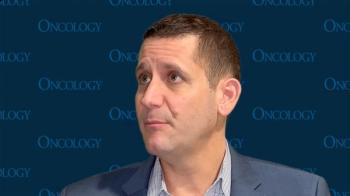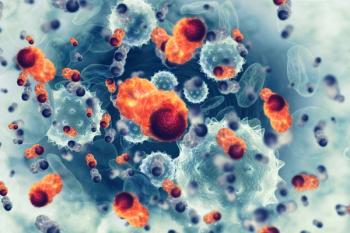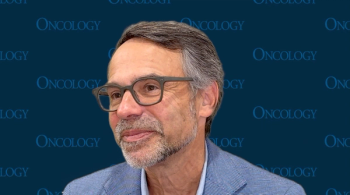
Advanced Ovarian Cancer Shows Persistent Time Without Progression With Combination Niraparib/Bevacizumab
Data from the phase 2 OVARIO study showed extended progression-free survival benefit of niraparib plus bevacizumab in patients with heavily pretreated advanced ovarian cancer.
At an 18-month analysis of the phase 2 OVARIO trial (NCT03326193), progression-free survival (PFS) benefit persisted in a majority of patients with advanced ovarian cancer who were previously treated with frontline platinum-based chemotherapy and bevacizumab (Avastin) and went on to receive combination therapy of niraparib (Zejula) and bevacizumab. These findings were presented during the Society of Gynecological Oncology 2021 Virtual Annual Meeting on Women’s Cancer.1
Results from the single-arm, open label study showed that 62% (40 events; 95% CI, 52%-71%) of patients in the overall treatment population (n = 105) remained progression free at an 18-month follow-up. This followed a 6-month follow-up that showed 90% (95% CI, 82%-95%) of patients remained progression free and a 12-month follow-up where 75% (95% CI, 66%-83%) of all patients remained progression free.
The study assessed newly diagnosed patients with high-grade serous or endometrioid stage IIIB to IV epithelial ovarian, fallopian tube, or primary peritoneal cancer who had a previous complete response (CR), partial response (PR), or no evidence of disease result on frontline platinum-based chemotherapy plus bevacizumab. Patients were treated with niraparib and bevacizumab to improve PFS.
Previous data had shown the benefit of niraparib as a monotherapy to improve PFS, but the AVANOVA study (NCT02336193) showed a significant improvement in PFS (HR, 0.35; 95% CI, 0.21–0.57, P < .0001) for patients on the combination therapy compared to monotherapy,2 leading investigators to look further into the combination with OVARIO. The primary end point was PFS rate at 18 months with secondary end points including overall survival (OS) and safety.
Researchers also divided the patients into 3 other sub-cohorts based on the patients’ biomarker status, with 47% (n = 49) of patients being homologous recombination deficient (HRd) with 28% (n = 29) of those patients being HRd BRCA mutated and 15% (n = 16) having an HRd BRCA wild-type mutation in their cancer. Thirty-six percent of patients (n = 38) exhibited HR proficiency (HRp) and 17% (n = 18) had an inclusive test, failed testing, or had insufficient tissue to determine their HR status (HRnd).
“Inhibition of vascular endothelial growth factor can lead to acute hypoxia that can drive genomic instability by altering DNA damage repair pathways, including homologous recombination,” the investigators, led by Melissa M. Hardesty, MD, MPH, of the Alaska Women’s Cancer Center, wrote in their poster presentation of the data. “Therefore, it is hypothesized the bevacizumab may sensitize tumors to poly(ADP-ribose) polymerase inhibition (PARPi).”
These HRd, HRp, and HRnd groups also displayed improved PFS rates with the combination of niraparib and bevacizumab at the 18-month follow-up, with PFS rates of 76% (95% CI, 61%-87%), 47% (95% CI, 31%-64%), and 56% (95% CI, 31%-78%), respectively. The overall HRd group exhibited the highest PFS rates of the biomarker matched subgroups through the follow-ups with 98% at the 6-month follow-up and 88% at 12 months.
Patients on the trial were a median age of 60-years-old with 66 patients having an ECOG performance score of 0, and the most common stage of diagnosis being stage IIIC cancer in 71 patients. One-hundred patients had serous disease at the time of diagnosis, 4 had endometroid, and 1 patient had undifferentiated histology. Seventy-four patients’ primary tumor site was in the ovaries, 19 patients had cancer in the fallopian tube, and 12 had primary peritoneal cancer. All patients were given either 200 mg (78%) or 300 mg (22%) of niraparib daily based on baseline body weight and platelet count and was started within 12 weeks of completing frontline therapy. This was given in addition to bevacizumab at 15 mg/kg every 3 weeks.
Safety was a secondary end point of the study, which researchers found the combination of niraparib and bevacizumab to exhibit consistent adverse effects with ones previously seen with each drug as a monotherapy; no new safety signals were observed. However, 99% of patients experienced a treatment-related treatment-emergent adverse event (TEAE) of any grade with 27% of patients discontinuing because of a treatment-related TEAE. According to the researchers, this rate of treatment discontinuation was consistent with other PARPi plus bevacizumab studies as the rate is higher among combination treatments compared to monotherapy.
Seventy-seven percent of patients experienced a grade 3 or higher treatment-related TEAE, which included thrombocytopenia (39%), fatigue (10%), anemia (34%), nausea (1%), hypertension (27%), proteinuria (5%), headache (6%), and neutropenia (12%). The most common treatment-related TEAE of any grade was thrombocytopenia in 70% of patients, followed by fatigue (57%), anemia (52%), and nausea (52%).
References
1. Hardesty M. Phase 2 OVARIO Study of Niraparib +Bevacizumab Therapy in Advanced Ovarian Cancer Following Frontline Platinum-Based Chemotherapy with Bevacizumab. Poster presented at: Society of Gynecological Oncology 2021 Virtual Annual Meeting on Women’s Cancer; March 19-21, 2021; Virtual. Poster 22.
2. Mirza MR, Lundqvist EÅ, Birrer MJ, et al; AVANOVA Investigators. Niraparib plus bevacizumab versus niraparib alone for platinum-sensitive recurrent ovarian cancer (NSGO-AVANOVA2/ENGOT-ov24): a randomised, phase 2, superiority trial. Lancet Oncol. 2019;20(10):1409-1419. doi:10.1016/S1470-2045(19)30515-7
Newsletter
Stay up to date on recent advances in the multidisciplinary approach to cancer.
















































































